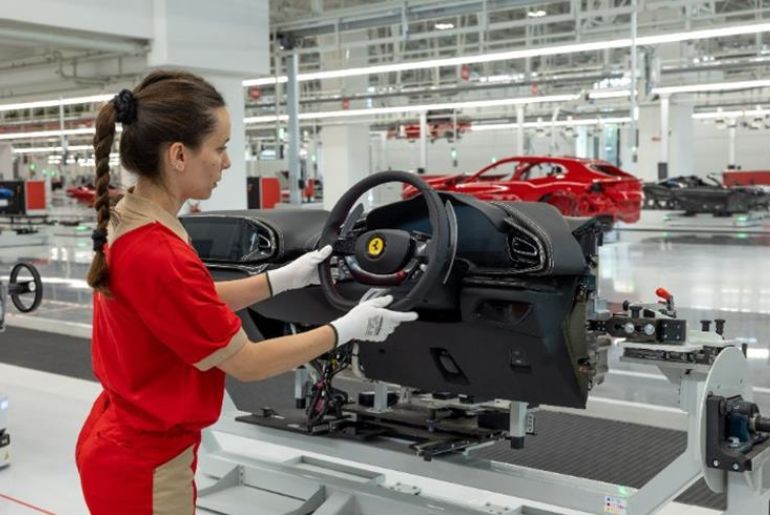With the commissioning of the new E-building production facility at its Maranello factory, Ferrari has taken a big step toward the launch of its first electric vehicle (EV) early next year.
The new 42,500 square meter plant was inaugurated in front of Italian President Sergio Mattarella with the goal of giving the Italian supercar manufacturer the most “production flexibility.”
Ferrari claims that the ‘E’ in the building’s name stands for “energy, evolution, and environment” rather than for electric and will be utilized for the construction of the company’s first electric vehicle as well as combustion-engine and hybrid vehicles.
Production is set to get under way in January 2025, with the Purosangue and SF90 likely to be the first to run down the new state-of-the-art line.
Ferrari said that housing production and development of all the powertrain types it will use in the coming years in a single building is in line with its strategy of “prioritising revenue quality over quantity”.
High-voltage batteries, electric motors and axles – which were cited as “strategic electric components that are highly relevant to differentiating Ferrari’s technology and performance” – will also be assembled there.
While Ferrari has confirmed that it’s working on an EV, it has remained tight-lipped on any technical details so far. Early patents suggested it could take the form of a four-wheel-drive two-seater and suggested a price tag starting from €500,000 (Rs 4.4 crore).
Company CEO Benedetto Vigna emphasised the advantages of building a new factory for the upcoming EV: “The full electric Ferrari demands new technologies, components and processes, which we want to design, engineer and handcraft here in Maranello. As such, we have specifically invested in the E-building, it will enable us to keep our know-how in-house and maintain our competitive advantage in the years to come.
“By mastering this full system, we can make a palpable difference. It will ensure that an electric Ferrari continues to deliver the distinctive driving thrills that all Ferraris have.”
The decision to produce batteries and motors in house is a significant statement of intent in Ferrari’s desire to have maximum control over its future products.
More than 300 staff will work in the E-building. Training for the new production lines started more than two years ago, and Ferrari said that process has been vital to “strengthening knowledge” required for motor production and battery assembly.
While Maranello will retain a far greater level of manual assembly than mainstream car factories, production in the E-building will be assisted by a number of collaborative robots.
The E-building has taken two years to build, on a site to the north of the existing campus. Ferrari said it hasn’t increased its overall footprint, however, through the replacement of obsolete structures.
It contains four levels, with floors dedicated to general systems; vehicle assembly and logistics; and vehicle assembly, engines and components. There’s also a mezzanine with office space.
Ferrari said the E-building has been built to the highest levels of energy performance, with more than 3000 roof-mounted solar panels capable of generating a peak power output of 1.3MW. It will be powered entirely by renewable energy.
There will also be a large storage tank to collect rainwater that can then be treated and reused, while more than 60% of the energy uses for battery and motor testing will be recovered using accumulators.
Ferrari has also redeveloped the road infrastructure around the new building to move traffic away from the main pedestrian routes and constructed a new road and bike path for access.


